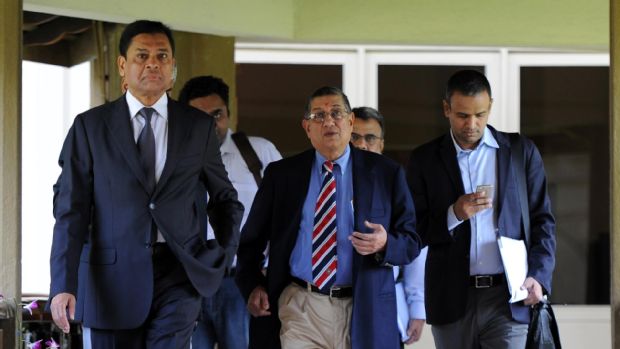Mukul Kesavan in Cricinfo
What sort of cricketing culture sees conflict of interest as normal? The answer lies in the history of cricket administration in India.
Long-time observers of the BCCI know that it used to be cricket's answer to the medieval city state. No Medici controlled Florence as comprehensively as the BCCI controlled cricket in India. The Board of Control was an independent principality, located in India, surrounded by India, but not of India. Its jurisdiction over cricket in India was as absolute as the Vatican's over Catholicism; it brooked no interference in its affairs, not even from the nation state that enclosed it.
Its last pope showed his cardinals that he was the god of most things by turning conductor and orchestrating a symphony of conflicting interests. His orchestra pit was crowded with cricketers, ex-cricketers, captains, captains of industry, consultants, commentators, cooing starlets, all on the same page, bobbing to his baton. During his reign most living things in cricket's jungle became the board's creatures, bound by contract, muted by money and sworn to servility. Not everyone: the Great Indian Bedi, never a herd animal, wouldn't be corralled, but he was an exception. Most errant beasts that held out were forced back into the fold by the threat of excommunication. In the context of the godless present this meant not the eternal absence of the Lord's grace, but the permanent loss of the board's cash.
The board's independence was secured not by defying Leviathan but by co-opting it. Sharad Pawar, Arun Jaitley, Rajeev Shukla, even Narendra Modi, have all helped administer cricket in India. Unluckily for the BCCI, the Supreme Court couldn't be squared, and so this cricketing emirate with Dubai's soul and Abu Dhabi's reserves finds itself in danger of being regulated like a public sector undertaking.
The recent Supreme Court ruling got one thing exactly right: Indian cricket's original sin was the amendment of the virtuous clause in the BCCI's constitution that barred its office holders from taking a financial stake in any matches or tournaments organised by the board. It was this (retrospective) amendment that allowed N Srinivasan, then treasurer of the BCCI, to buy an IPL franchise, Chennai Super Kings. The conflict of interest that this created - especially after Srinivasan rose to become the president of the BCCI - was so enormous, so brazen, so perversely exemplary, that people involved with cricket's economy felt free to wallow in their own, smaller, conflicts.
One of the board's many apologists, appearing on a televised discussion of the Supreme Court's intervention, ingeniously cited the many conflicts of interest that Srinivasan's example had engendered, to normalise his own. If men like MS Dhoni and Rahul Dravid could hold sinecures at India Cements while captaining teams in the IPL, why were people so exercised about Srinivasan's double role?
The short answer to this is that a) Srinivasan's position as Indian cricket's primate and CSK's boss made his conflicts of interest a systemic threat to the health of Indian cricket, and b) Srinivasan's conflicts created an actual, not theoretical, crisis of credibility for Indian cricket. But it's worth taking the apologist's question seriously and supplying a longer answer to understand the cricketing culture that allowed these conflicts of interest to seem normal, even legitimate.
While trying to understand Indian cricket's deafness to the notion of a conflict of interest, it's useful to bear in mind a historical fact: the BCCI transitioned from an oligarchy of patrons to an oligarchy of rentiers and entrepreneurs inside 20 years.
Nominally, the BCCI presides over a pyramidal system of cricket administration based on indirect election. In actual fact most electoral colleges are owned by local grandees. Often a business family will dominate the local cricket association for decades. The elections that legitimise the present system have more in common with the politics of rigged pocket boroughs in 18th-century England than the broad democracy of republican India. Elections to the BCCI, the apex body of Indian cricket, are often accompanied by a chorus of allegations about rigging, gerrymandering and accreditation.
The BCCI is run by a cabal of colonial-style patrons. This self-perpetuating clique struck oil less than 20 years ago. It recognised the potential of revenue streams created by economic liberalisation and successfully connected an opaque club of amateur administrators with real money. The coming of cable television and the consolidation of a national television audience created the revenues that underwrote the first generation of endorsement superstars: Kapil Dev, Azharuddin, Tendulkar. Once, Doordarshan telecast cricket as a kind of republican duty to India's cricket-mad citizens; then private television channels learnt it was a privilege for which they had to pay vast sums.
The game was so comprehensively monetised that the BCCI began demanding fees to permit the photographing of matches and the broadcasting of radio commentary. The idea that cricket was news or even that it was an event in the real world that could be reported on, gratis, gave way to the idea that cricket was proprietary entertainment that could only be captured in pictures or the spoken word for a fee. ESPNcricinfo briefly stopped calling IPL teams by their franchise names because it was advised that these names were commercial properties that couldn't be used without payment.
The monetising of cricket occurred within an administrative culture where the BCCI's officials still saw themselves as "honorary" patrons. Before the boom these men had leveraged their status as cricket's patrons into social standing as city grandees. For ex-rajas and aspirational businessmen - traditionally, big business didn't bother with cricket - cricket was a way of being someone on the regional or national stage.
N Srinivasan's back story fits the model. He ran India Cements, he was genuinely interested in sport and he was a pillar of Madras society. For him, as for the Rungtas in Rajasthan or Dalmiya in Bengal, cricket was a route to social consequence and the public eye. In Madras, Srinivasan was preceded as patron by two other industrialists, AC Muthiah and his father MA Chidambaram, after whom the stadium at Chepauk is named. It's important to recognise that men like Chidambaram, Muthiah and Srinivasan didn't make money out of the game before the boom. They actually spent their own money subsidising cricketers and cricket because this was what patrons did.
In this way the men who governed Indian cricket came to see themselves as benefactors and the men who played cricket in India learnt to recognise them as such. Through the long shamateur epoch of Indian cricket, cricketers were supported by sinecures in private companies and public sector undertakings, and socialised into the role of dependent clients. It was a recognition forced upon them by the need to make a living in a sport that had no business model and generated no money.
These patron-client relationships survived the monetisation of Indian cricket, which happened, it's worth remembering, with bewildering speed. Even after successful cricketers became rich men, members of a sporting super elite, they went along with being infantilised as clients. There were three broad reasons for this.
One, gratitude. They remembered the hard times and were grateful for the support that patrons like Srinivasan had extended to the sport. India Cements had dozens of players on its rolls. It supported league cricket in Madras and helped players - not necessarily international players - make a living. (It wasn't alone in this. Sungrace Mafatlal supported cricket generously in Bombay; Sachin Tendulkar joined its Times Shield team in 1990 after his Test debut. It is something of an irony that this fabric brand didn't survive the economic liberalisation that helped make both Tendulkar and the BCCI fabulously wealthy.)
Two, pragmatism. Players recognised that while the financial basis of the sport and their own financial standing might have been transformed by sponsorship, endorsements and television revenue, the men who ran this new money-spinning machine were the same patrons who had run the shamateur, shabby-genteel set-up in the earlier era. It made complete sense to say yes if a patron like Srinivasan wanted you on his rolls even if the money from the sinecure made no real difference to your net worth.
Three, fear. To annoy the BCCI was to be exiled from Indian cricket and its economy; it was much safer to acknowledge the power of these "honorary" patrons than to be your own man. Here the ruthless purge of the Indian Cricket League rebels was the cautionary tale. A board that could unperson Kapil Dev, arguably the greatest Indian cricketer of the television age, for daring to dabble in an unauthorised league, was not to be crossed.
Thus, administrators like Srinivasan, persuaded of their virtue because of their generosity as patrons, were consumed by a sense of entitlement that made the very suggestion of a conflict of interest an impertinence. And players, used to deferring to patrons who made their livelihoods possible, found it hard to break the habit of clientage even when they didn't need the money. The idea that a sinecure might constitute a conflict of interest must have seemed preposterous: how could something endorsed by Srinivasan, uber-patron and undisputed master of the cricketing universe, be wrong?
Now that the Supreme Court has ruled that he was wrong, that there is such a thing as a conflict of interest and that the amendment of rule 6.2.4 was illegal, Indian cricket's supple auxiliaries have started airing their doubts about Srinivasan. The ex-player, the ex-IPL franchise manager, the marketing consultant, the sports management agent, the plausible commentator, have begun shyly sharing their long-brewed conviction that something was amiss. Shyly, because it isn't yet clear that the sheikh is dead, and given Srinivasan's past resilience who can blame them?
Will Indian cricket be regulated into virtue by the Supreme Court? It's hard to tell. But we do know that a precedent has been laid down by the court: the judiciary has stepped in and taken charge of the affairs of the BCCI. It has dismissed the BCCI's claim of being a private body. It has amended the BCCI's constitution, instructed Srinivasan to either sell CSK or withdraw from board elections, and assigned the reform of the board to a committee of three retired judges. It'll be a nice irony if the crony capitalism of this cabal becomes the proximate cause of a creeping nationalisation of Indian cricket.
Three, fear. To annoy the BCCI was to be exiled from Indian cricket and its economy; it was much safer to acknowledge the power of these "honorary" patrons than to be your own man. Here the ruthless purge of the Indian Cricket League rebels was the cautionary tale. A board that could unperson Kapil Dev, arguably the greatest Indian cricketer of the television age, for daring to dabble in an unauthorised league, was not to be crossed.
Thus, administrators like Srinivasan, persuaded of their virtue because of their generosity as patrons, were consumed by a sense of entitlement that made the very suggestion of a conflict of interest an impertinence. And players, used to deferring to patrons who made their livelihoods possible, found it hard to break the habit of clientage even when they didn't need the money. The idea that a sinecure might constitute a conflict of interest must have seemed preposterous: how could something endorsed by Srinivasan, uber-patron and undisputed master of the cricketing universe, be wrong?
Now that the Supreme Court has ruled that he was wrong, that there is such a thing as a conflict of interest and that the amendment of rule 6.2.4 was illegal, Indian cricket's supple auxiliaries have started airing their doubts about Srinivasan. The ex-player, the ex-IPL franchise manager, the marketing consultant, the sports management agent, the plausible commentator, have begun shyly sharing their long-brewed conviction that something was amiss. Shyly, because it isn't yet clear that the sheikh is dead, and given Srinivasan's past resilience who can blame them?
Will Indian cricket be regulated into virtue by the Supreme Court? It's hard to tell. But we do know that a precedent has been laid down by the court: the judiciary has stepped in and taken charge of the affairs of the BCCI. It has dismissed the BCCI's claim of being a private body. It has amended the BCCI's constitution, instructed Srinivasan to either sell CSK or withdraw from board elections, and assigned the reform of the board to a committee of three retired judges. It'll be a nice irony if the crony capitalism of this cabal becomes the proximate cause of a creeping nationalisation of Indian cricket.




